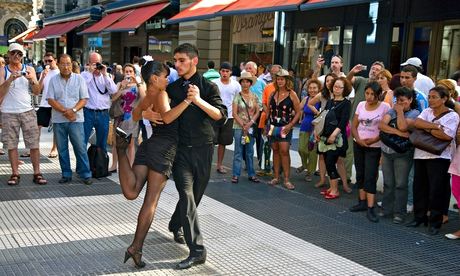
Tourists in Argentina are suddenly finding their money will go a lot further than it did just a few days ago. The peso has gone into freefall, plummeting just over 17% against the dollar in two days.
As an example, a seven-course tasting menu at HG Restaurant at the Fierro Hotel in Palermo, named as one of the 50 best restaurants in Latin America in 2013, now costs £27 compared with £36 a month ago.
Hotelier Martin Rosberg, who runs the Fierro Hotel where the restaurant is based, explains: "Argentina has suddenly got cheaper – and that's with the official rate, not the blue rate."
Since the country's government introduced tough currency change restrictions on its people, a black market has emerged. In short, you can change your money at an official outlet for one price; or you can go to an unofficial trader and get it changed at the "blue" rate – which will put many more pesos in your pocket. Taking plenty of hard cash contradicts the usual advice to tourists travelling abroad, but many visitors to Argentina have been doing just that to take advantage of the black market rates.
Numerous websites and Twitter accounts have emerged to keep visitors and locals up-to-date on the two parallel rates, such as @DolarBlue. Even newspapers report on the two, side by side. "I've stood behind tourists in the bank, watching them hand over dollars to change them at official rate, and wanted to scream, Noooooo!" says one expat, who has been working in Buenos Aires for over 10 years.
So how do you track down the more favourable blue rate? Many foreign visitors set up a local contact who can make the change, or ask their hotel to recommend a "cueva" (literally meaning cave; in reality, more like fully functioning businesses, accepting dollars, euros and pounds). Other tourists simply head to central shopping streets and respond to not-so-subtle calls of "Cambio! Cambio!" (exchange); the wise ones having checked the current rate first, so they can barter.
"It was a pretty surreal experience," says one British tourist, who just returned from a trip to Buenos Aires. "An acquaintance recommended a place was given an address, on the upper floors of an office building. I had to explain myself in very limited Spanish, but they knew what I was there for. It was a fully organised operation. It's not something you expect to do on holiday, but not really a problem, as it turned out."
Dan Clarke, the director of RealWorld, a tour operator specialising in South American travel, offers this advice: "Although changing money through non-official channels is illegal, it is a fact of daily life in Argentina at the moment. You can run the risk of ending up with some forged notes, but you'll also exchange at sometimes 30% better than the official rate. If possible, ask someone you trust – like a good local rep – for recommendations."
If you want to stick to using US dollars in your day-to-day transactions, that's common too. The Argentinian market, which experienced a complete economic meltdown in 2001/02, has quickly adapted. Many businesses, including hotels and restaurants, will accept US dollars. Some will work to the blue rate, even though that is illegal, or they will come close to it. When a shopkeeper recognises you are a tourist, you are likely to be offered an upfront deal: "We accept dollars at 12 pesos", or something similar.
The dual rate began after the government initiated a number of restrictions on currency exchange in an attempt to prop up the fledging peso and reduce capital flight (ie investors taking their fortunes out of the country). Argentinians have, of course, been hit much worse than any visitor. There has been a prohibitive amount of red tape they have to get through if they wanted to exchange pesos to dollars. If they wanted to use credit cards abroad, the government taxed them a whopping 35 per cent on each transaction. Online shopping has also been curbed (Want a parcel from eBay delivered to your door? Forget about it). After the peso has gone into freefall, falling just over 17 per cent against the dollar in the last two days, the government is now scrabbling to relax some restrictions (those credit card taxes will fall to 20% from Monday).
After a tough few years battling the effects of high inflation (believed to run at almost 30%), the tourist industry could experience a boom, as it did in the mid-2000s, when tourists were able to get more for their money and new boutique hotels seemed to open every five minutes.
Meanwhile, Argentinians face the grim reality of yet another financial crisis.

